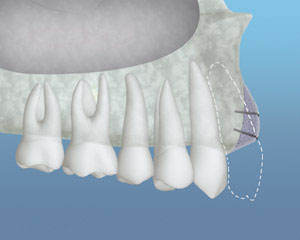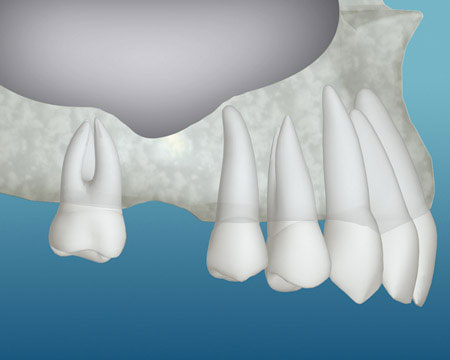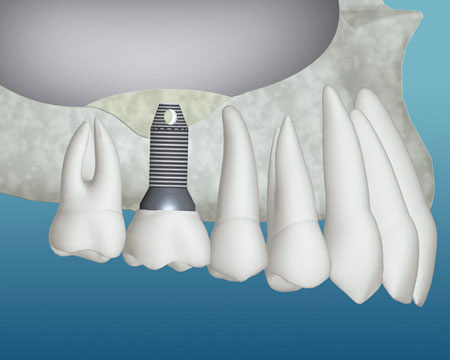Bone Grafting for Dental Implants in St. Augustine, FL
For many patients considering dental implants, bone grafting plays a critical role in preparing the mouth for long-term success. Whether due to tooth loss, gum disease, or natural deterioration over time, not all patients have enough healthy bone tissue to support an implant right away. Fortunately, advanced grafting techniques can restore lost bone tissue and rebuild the foundation needed for a strong and lasting connection between the jawbone and dental implants.
At our practice in St. Augustine, we offer several forms of bone graft depending on your specific needs. These procedures are commonly performed in-office under local anesthesia and are essential for achieving successful implant placement when the jawbone is compromised
When Bone Grafting Is Necessary
Tooth loss can lead to bone loss, especially if replacement treatment is delayed. When a tooth is missing, the jawbone no longer receives stimulation from chewing forces, and bone tissue begins to shrink. If this continues over time, there may not be enough bone left to place a dental implant. Bone grafting is often recommended in these cases to rebuild the lost structure.
Bone grafting may also be necessary if you’ve had periodontal disease, tumor surgery, or traumatic injury that damaged your jaw. These issues can all affect the volume and density of the jawbone. Bone grafting restores the foundation, promotes new bone growth, and makes it possible to proceed with implant placement even after substantial bone loss.
Types of Bone Grafting Procedures
One common form of bone graft is performed immediately after a tooth extraction. If the socket walls are thin, especially in the upper and lower front teeth, your jaw may not heal properly without assistance. In such cases, bone grafting material is placed in the socket to maintain the shape and density of the area. This prepares the site for dental implants a few months later.
For patients missing teeth in the upper jaw near the molars and premolars, sinus bone grafts may be needed. Over time, the sinus cavity can expand into the area once occupied by teeth, reducing available bone height. A sinus grafting procedure lifts the sinus membrane and places grafting material to promote new bone growth. This helps replace bone in the upper jaw and allows implants of appropriate length to be securely anchored.



Bone Grafting Materials and Healing
Bone grafting procedures can use a variety of materials, including bone from the patient, synthetic options, or bone sourced from a certified tissue bank. The goal is always the same – to create healthy bone tissue that will bond with the existing jawbone and support a future implant.
The healing process after a bone graft can take several months, depending on the extent of grafting needed and your body’s natural response. During this time, the new material integrates with your jaw and encourages the regeneration of strong, dense bone. This process lays the groundwork for successful implant placement and restores the structure needed to support new teeth.


The Connection Between Gum Health and Bone Grafting
Gum disease is one of the leading causes of bone loss in adults. If left untreated, it can weaken the bone structure around your teeth and compromise your eligibility for implants. By addressing gum disease early and restoring damaged areas with bone grafting, patients can rebuild their oral health and restore their smile. Bone grafting is not just about replacing lost bone – it’s about preserving the integrity of the jaw and the function of your mouth. Whether you’re preparing for implants or recovering from gum-related bone loss, timely treatment can make all the difference in long-term outcomes.Advanced Grafting Techniques and Modern Technology
Modern dental practices use advanced grafting techniques that improve healing time, comfort, and success rates. These techniques include the use of growth factors to stimulate bone development, as well as guided tissue regeneration that protects the grafted area during healing. In some cases, digital imaging and 3D planning technology are used to map the structure of the jaw and ensure precise placement of both the graft and the future implant. These innovations not only enhance the accuracy of the bone grafting procedure but also make it safer and more predictable. For patients in St. Augustine, this means receiving state-of-the-art care that minimizes discomfort and maximizes the chances of long-term success.What to Expect After a Bone Graft
Healing is a critical part of the bone grafting process. Most patients experience mild swelling and discomfort for a few days after the procedure, which can be managed with over-the-counter pain relief and proper aftercare. The use of local anesthesia ensures that the procedure itself is comfortable, and many patients return to normal activities within a day or two. Over the next few months, the grafted material will gradually integrate with your jaw bone. Your dental team will monitor this healing closely to determine when your jaw is ready for implant placement. The timeline depends on the size of the graft and your body’s natural healing response, but the result is the same – a strong, healthy foundation for new teeth that look and feel natural.Trust Local Experts in Bone Grafting – St. Augustine, FL
Bone grafting in St. Augustine, FL, is a routine and effective procedure that helps patients move forward with dental implant treatment. Whether you’re dealing with lost bone tissue from previous tooth loss or need a “sinus grafting procedure” to support implants in the upper jaw, our experienced team uses advanced techniques and high-quality materials to deliver optimal results. If you’ve been told you may not have enough bone for implants, don’t give up hope. With the right bone grafting procedure and a customized treatment plan, dental implants may still be an option. Schedule a consultation today at 904-460-0505 to learn more about your options and take the first step toward restoring your smile with confidence.FAQs about Bone Grafting for Dental Implants
What is bone grafting and why is it needed for dental implants?
Bone grafting is a surgical procedure that rebuilds or replaces bone in the jaw to prepare for successful implant placement. When bone loss has occurred due to tooth loss, gum disease, or other conditions, there may not be enough healthy bone tissue to support a dental implant. Grafting encourages new bone growth and creates a stable foundation for long-term results.
How long does it take to heal after a bone graft?
Healing time after a bone graft varies based on the type and size of the graft. Most patients need three to six months for the new bone tissue to fully integrate with the existing jawbone. During this time, your dentist or oral surgeon will monitor healing and determine the best time to move forward with placing dental implants.
Is bone grafting painful?
Bone grafting is generally well-tolerated and is performed under local anesthesia, sometimes with sedation. Most patients report mild discomfort for a few days after the procedure, similar to that of a routine tooth extraction. Pain can be managed with over-the-counter medication and post-operative care instructions from your dental team.
What materials are used for bone grafting?
Bone grafts can be made from your own bone, donor tissue from a certified tissue bank, or synthetic materials designed to support bone growth. The choice depends on your specific needs, overall health, and the location of the graft. Your dental specialist will recommend the best option to achieve healthy bone tissue and long-term success.
Can I get dental implants without a bone graft?
Some patients have enough jawbone to support implants without grafting, especially if tooth loss is recent. However, if you have lost bone tissue due to gum disease, tooth loss, or aging, bone grafting may be necessary. A thorough exam, including X-rays or 3D scans, will determine whether you need grafting before moving forward with dental implants.